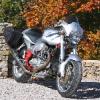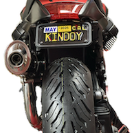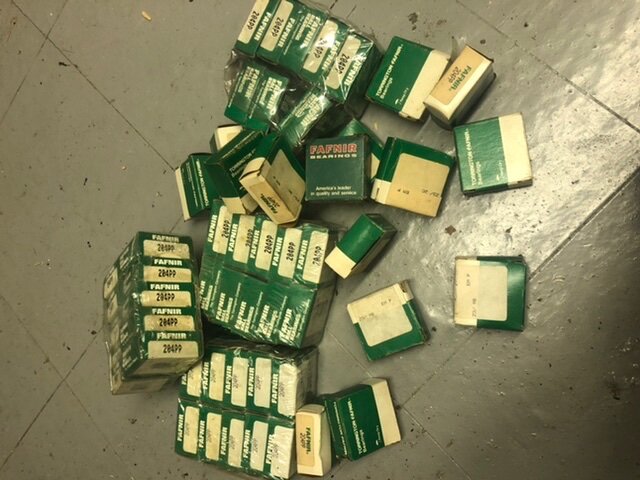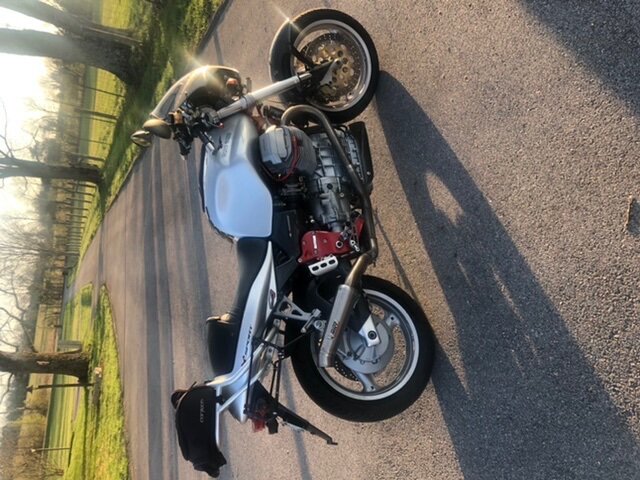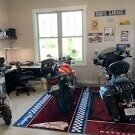Leaderboard
Popular Content
Showing content with the highest reputation on 03/28/2023 in all areas
-
5 points
-
Ok, I'm obviosly not an expert at posting pics, these look huge. The the tank has been raised slightly to allow access to subframe bolts...rear bolts are out and frame has been pivotted down to provde clearance to facilitate cam chain cover removal. The cam chain cover original gasket. It was seeping at the tan colored spot on the right a most halfway, down. The gasket was easily remioved, it was brittle and no gasket sealer was evident. I'm going back on with one of those "metal core" gaskets.4 points
-
4 points
-
Yeah, I recall there is "some disassembly required" to get to the magnets . . . At which point the inspection will be telling. This starter was locked:4 points
-
Wheels are forged OZ. Ghezzi-Brian had a batch made and I got a good deal on them. Much lighter than OEM and together with Öhlins goodies it improved handling very much!4 points
-
Cool. I retrieved the starter from Gene the Starter Guy. He cleaned the commutator and solenoid, there was a great deal of oil residue and build up of gunk that was getting into the solenoid can intermittently stopping the current from offering full trust to the flywheel. If I understand him correctly... No unglued magnets. I do not see oil from either the engine rear main or trans front seal looking into the starter opening on the engine however, the gunk-up solenoid was the issue. Twenty-on year old Guzzi... I have cycled the starter thirty (30) times and it does not fail to start... I shut the engine off by both the ignition switch and the kill switch, and turned the bars left to right repeatedly looking for wire strain in the switch, it always started. Thanks much for the assistance here. You guys are the best. Rob3 points
-
I have the problem of South Florida- heat cycles, intense sun, humidity and rain. I've taken to using aerosol Cosmoline on everything that needs preservation without lubrication. https://www.cosmolinedirect.com/cosmoline-rp-342-heavy-spray-military-grade-rust-preventive/3 points
-
I think that anything is better than dry assembly if the bike ever gets wet. Jointing compound, anti-seize, or grease, are all good.3 points
-
MM didn't have top 10 pace but qualified on pole by getting a tow, and then when the race starts surprise surprise he can't keep up, he then reverts to his default setting of red mist and over riding and the inevitable happens.3 points
-
I did some maintenance on my 2001 V11 sport today. I pulled the rear drive off to inspect bearings for the most part and found the (outboard?) needle bearing was in need of attention. It was full of rock hard, dried up grease. It’s grease seal was also in bad shape. I don’t believe it has worked as a roller bearing for years. I disassembled it and cleaned it, repacked it with grease, and put it back into service but I’ll be ordering a new bearing for later. I replaced the wheel bearings as well. Easy task once you have the wheel off ! The front wheel bearings failed years ago so I suspected the rears needed replacement by now, 49,000 miles. Otherwise the rear drive felt nice, looked nice. On a lighter note, If anyone is need of a wheel bearing while traveling through Kentucky, I’ve got your back. I have extras 😜3 points
-
I suspect Quartararo feels slighted because last year he took out Aleix Espargaro with a similar move and was rightly penalized. But to be fair, Quartararo's move was way more aggressive. He threw it in there really late and it was never going to work. I have not studied Marini's move but initially it appeared to be just a case of loosing the bike while inside another rider. Perhaps Marini should also get a penalty, but from first glance it did not look overly aggressive. But there's the rub. Judgement calls are tricky. Where is the line that, if you cross it, you get a penalty? Some moves, like Marc's, are clearly over the line. But other moves aren't. Where is the line between hard racing and dangerous riding? I am not sure there should be a penalty every time a racer hits or crashes another racer. Some incidents are racing incidents. But figuring out where the line between the two is can be tricky.2 points
-
Obviously we wouldn't be here if weren't interested in old motorcycles. Your conclusion agrees with me, that Ducs are pretty much in the ballpark cost wise as the rest of the field. Going through maintenance headaches with all of my older motorcycles and having to get rid of one, I find my newer Ducati to be so much better. It's been reliable and shines in comfort and performance beyond any my legacy bikes. I did purchase my Duc used. My advice, keep your eye o n a bike that you might likes, test ride it if you can, then wait for a good used one to come on the market. Break in period done, recalls done, lots of pampered bikes with riders that don't really ride that much.2 points
-
Ok, I answered my own questions... There is a sub-frame on the Lemans that the regulator, cooler & horns mount to that bolts to the spine, the cam chain cover will not clear it, So, now I'm struggling with the fuel tank quick disconnects, get the tank off, loosen/remove sub-frame to facilitate cam chain cover removal. Funny, the last time I disconnected the tank fittings it was easy...not so easy now.2 points
-
I agree with @KINDOY2, Marc didn't have the pace but he did what he has always done (got a tow). He has done that a lot. He is clearly talented. But I always found it funny that he does what so many amateur racers do, increase their pace by following others. Not just to get a slipstream down the straight but he also uses them as a carrot to help him go faster through the twisty bits. Seems odd to have such a talented and successful racer using such a amateur trick. That said, having him back in the middle of the front group it seemed inevitable that something like this would happen. It isn't the first time he has done something like this and I doubt it will be the last. At least the other racers (Oliveira aside) can rest easy knowing Marc will be out for a few races. II was really hoping Oliveira could deliver for Aprilia. It is great to finally have a fast guy on the Ape. But his season is probably ruined now. Maybe Vinales can be consistently fast, but that seems unlikely. Oliveira seemed like Aprilias best hope. Either way, I am enjoying the season. I like the addition of the sprint races.2 points
-
I wish I had a nickel for every time I forgot a sidestand. I was conflicted about removing the auto-retract feature from my 'Sport, but it's been on the ground 4 times due to the auto-retract, and zero times from hitting the stand while moving. So off it went. Starting in gear, not so common but pretty familiar also. :/2 points
-
I am dreaming of the days when I did not have to depress the clutch to start either my motorbike or my car today. Until the Le Mans, I had never owned a bike with having the side stand deployed cut the engine if in gear. Zero is the number of times I attempted to start my bike while in gear; including kick starter. Zero is the number of times I forgot to fold the the side stand. I know, suffice one time to mule over the: "how could I forget it".2 points
-
Well here is my personal review of the MIVV cans on a V11 sport. The MIVVs sound amazing. They make the V11 sound exactly what I always wished it would sound like ! Very vocal yes, they talk the talk yet at highway cruising speeds they mind their manors. And the tone is so nice. I’ve had riding buddy’s comment that they sound almost like a musical instrument. The style, build quality, and price are all “on point”. I love um.2 points
-
I lost all respect for him he ruined Rossi's championship run in '15. His antics and Dorna ruined a great finale for the title between Rossi and Lorenzo. He's sorta like Dale Earnhardt NASCAR period when Dale was allowed rough driving and perhaps was allowed a special car. OTOH, MM is talented and brave and I welcome his comeback after such an awful accident. I just see the same guy that's lost a step, on a slower bike with same level of aggression but very frustrated and mistake prone.2 points
-
2 points
-
1 point
-
The 'Definitive Guide to Rollerisation' This is something I've been meaning to do for a while as, despite the very youngest flat tappet bikes being nine years old now there are still a large number of them out there and in this post I'll try and cover both the procedure and pitfalls liable to be met during the rollerising process. Firstly let's cover which bikes need rollerising. Most importantly it is ONLY the four valve per cylinder, (8 valves all told so I'll refer to them henceforth as 8V's.) engines that were subject to the Flat Tappet Fiasco. None of the CARC bikes that use the venerable two valve per cylinder pushrod operated OHV engine suffer from chronic cam and lifter problems. Next, don't be fooled by the fact that some 8V models were referred to by the factory as '4V'. This nomenclature has been the source of some confusion but the easy way to identify an 8V motor is to simply look at their rocker covers. 8V motors have the 'Quattro Valvole' logo cast onto them and the back of the cover has a black plastic shroud over it. Like so. Both the 1200 Sport and the 'Small tank' Stelvio, (2008-2011.) were designated as 4V but use the 8V motor. Grisos and Norges were all designated 8V from the outset. No, I have no idea why either. Moving along from that we should look at which flat tappet 8V's need rollerising? The answer is simple. All of them. I know that some people are still in denial. Their engines don't make any unusual noises therefore everything is OK? Sadly, no. If people want to believe through magical thinking, or good luck, or using some special oil that "It isn't going to happen to them"? Well, good luck with that but the only person you'll be kidding is yourself. There is some anecdotal evidence that the last iteration, (There were at least three.) of the flat tappets will last longer than some of the earlier ones. I personally have seen no evidence of this. The problem is also very varied in when it manifests itself. Engines have been known to fail in a couple of thousand miles. Some soldier on for tens of thousands! Invariably though they will, all, eventually fail. With one notable exception all 8V's changed over to roller tappets and cams by the middle of 2012. The factory's engine numbers for the changeover point are listed as; Stelvio- Motor#AC12596 Build Date 12 March 2012 GRiSO - Motor#A813524 Build Date 12 April 2012 Norge - Motor#AA12214 Build Date 18 April 2012 The exception to this is 1200 Sports, none of which were ever made with roller engines at the factory. It's my belief that this is because the last of them were built before the advent of the roller top end and although they continued to be sold and plated as 'Current model' up until at least 2015 in the Australian market they were in fact 'New Old Stock' manufactured prior to rollers. We'll now move on to which 'Kit' will be required for any given bike. Due to changes made to some parts of the top end over the period of production of flat tappet bikes not all of them require the same parts to convert them from flat to roller tappets. For this reason Piaggio produced four different kits to perform the operation on the various engines. Which one you will need and the cost involved can vary enormously and not getting the right one means you can end up with a costly 'White Elephant' on your hands that may be hard to on-sell or can only be done so at a substantial loss. So let's look at this firstly with a timeline. The earliest 8V motors were made using chilled cast iron flat tappets, these were in 2007 through to early 2009. It quickly became apparent that there was a problem as the tappets started to fail. At this point, from memory around the end of 2008 or the beginning of 2009 the factory DID issue an actual recall but not to fit roller tappets as these hadn't been manufactured yet. The first attempted fix was to replace the chilled cast iron tappets with forged steel ones with a 'Diamond like carbon', (DLC.) coating on them. This was supposed to be 'The Fix' and as with all recalls was supposed to be publicised by both factory and dealers and, to their credit, most owners were so notified and in my experience it has been very rare to find a cast iron tappeted bike in circulation after the recall. The problem was it didn't fix the issue. 8V's, the 'Great White Hope' of the Guzzi range was self destructing at an alarming rate! Some geographical locations it seemed to be worse than others, (I for instance long remained skeptical about the problem because I just wasn't seeing it in bikes I'd serviced from new. My problem was I wasn't looking in the right place!). Then in 2012, after the launch of the porcine California 1400 which had the honour of being the first roller tappetted production engine the new roller top end was adopted across the 1200 range with the aforementioned exception of the Sport. This left though all the bikes manufactured before this time with wonky, failing top ends. 2007 to 2012 was a five year window when it should of been fixed but wasn't. Not only that but issuing a full blown recall would of been poisonously expensive. So they didn't. They fudged it. Instead of a recall there was what was described as a 'Technical Update' released on the Service Motoguzzi web portal laying out how the factory would handle it. Firstly it was stated that failures were a rare and unlikely event. They aren't. The attrition rate is 100%. There would be no pre-emptive replacements, the tappets had to fail before a claim would be accepted and the claim for a roller conversion kit was dependent on the owner having a full service history completed not just on distance but also on time, (So if you only did 5,000km a year you were still expected to get a full 10,000km service performed annually and recorded in your log book.). No service history? No kit! The inspection for damage had to be performed by an authorised dealer or service agent and provision of the kit was entirely discretionary. The owner was responsible for the labour component of both the inspection and, if the claim was successful, the installation of the kit. In certain markets with stronger protection laws there was a bit more wriggle room but for most people trying to negotiate a kit was and remains a nightmare. One not helped by the fact that even to this day many dealerships remain seemingly woefully ignorant of the whole sorry affair! So let's look at the four kits and what needs to be done to install them. Needless to say there is no sense at all in their identification as A, B, C and D kits don't follow any sensible timeline! First cab off the rank is bikes built from 2007 through to early 2010. These will all need to be fitted with the C kit. The C kit includes new camboxes, shims for under the inlet valve spring seats, valve guide oil seals for those valves, inlet and exhaust manifold gaskets, tampons, plug tube o-rings and rocker cover gaskets along with the hemispherical 'Pads' that go on top of the tappet towers in the rockers and all three thicknesses of head gasket. For reasons I won't go into here the larger inlet valves require shims under the spring seats. This means the heads have to be removed to fit them. Since you won't know what thickness head gasket you will require until the head is off the kit contains all three gaskets and this adds substantially to the price. There are ways to get out of this cheaper than purchasing th C kit but I'll cover that later. While removing the heads isn't that bothersome per se it can, on some models, most notably the Norge and Stelvio add substantial time to the whole rollerisation operation. Next up in the timeline are bikes built from early 2010 through to late 2011. These bikes require the B kit which doesn't contain manifold gaskets or head gaskets because during this period there were changes to either valve springs or the way the valve spring seats were machined rendering the shims under the spring seats redundant so on these bikes the heads do not have to be removed for rollerisation. From this point on on all models except the 1200 Sports the lack of need for the head to be removed is identified by a drill mark in the paint on the head on the side facing the valley of the engine adjacent to the manufacturing date stamp. From late 2011 through to the changeover to roller tappets at build in mid 2012 there were a number of revisions to the top end that I will cover in the next section. These bikes require the A kit which is similar to the B kit as it doesn't require the heads to come off so no head gaskets, or manifold gaskets are included. Finally, there are the final run 1200 Sports. These use the stand alone and stupidly expensive D kit. This contains all the gaskets as the heads have to come off to shim the inlet valve seats but, unlike the earlier Sports which were confusingly labeled 4V they use the later type heads and camboxes I'll cover in the next section. OK, having listed the kits we'd better work out what the differences are to the top ends of the motors and I'll explain why it is so important to get the correct type of kit for your engine. There are some traps for new players so it is important not to get it wrong as expensive damage can result if you get it wrong. There are basically two versions of the single spark 1200 Hi-Cam top end. The early versions that use the C and B kits and the later versions that use the A and D kits. Let's look at the differences. Most notable is the way the plug tunnel is sealed. On the right you can see the early system. These motors have a long plug tube that passes through the rocker carrier/cambox casting that is sealed at either end with an o ring. One in the head casting and one in the rocker cover. This system uses what is known as a 'Non floating' rocker cover. The later system can be seen on the left. On these machines the *Tube* is much shorter. It is still sealed at either end by an o ring but now it seals in the actual rocker carrier/cambox casting and the top of the tunnel is sealed by a neoprene gasket of the same cross section as the rocker cover gasket itself. This means that the rocker cover is not solidly indexed to the head or rocker carrier and 'Floats' relying on the comparatively light compression of the four cover bolts and their tampons to keep it in position. Note also that there are two different types of tampon and it is important to use the right ones if leakage is to be avoided. So let's first look at the rocker cover of the early type. Here you can see the plug tube and how it inserts in the cover. Note that when the rocker cover is lifted the tube may remain in the head or it may lift with the cover. Damper climates will tend to encourage the tube to rust into the cover and it will lift. Drier climates the tube will tend to remain in the head. Since it is a lot more bothersome to replace the o ring in the head it's a good idea to use some rubber grease on the top, rocker cover, o ring to encourage the rocker cover to come off the tube easier next time and leave the tube in the head. When removed from the rocker cover the pipe reveals the o ring and the groove in which it sits. Note there is no o ring in the groove on this cover. The later versions with the short tube have a similar groove machined into the bottom of the tunnel in the cambox casting. And the top of the plug tube is sealed between the carrier casting and rocker cover by the neoprene gasket. Which in turn fits into a groove in the inside of the rocker cover. Moving on to the two camboxes/rocker carriers there are notable differences here as well. By comparing the two side by side it is possible to see several reasons why they are not interchangeable. In the picture below you can see the later type at the top and the old type at the bottom. See also from looking at the pic above the hole in the casting of the old type is larger to accommodate the passage of the tube. The long tube simply won't fit through the 'New' casting. By looking at them from the side you can see the substantial difference in height of the plug tunnels. The shorter one being the old type as the plug tube pokes up through it to seal with the o ring in the rocker cover. The later one uses the casting itself to act as one of the mating surfaces for the circular gasket used with the 'Floating' cover. Note again new on the left, old on the right. And now we come to one of the, if not the most important difference between the two different assemblies and the reason one must make absolutely sure you choose the right one. During the time when the factory was thrashing around feebly trying to find a solution to the problem of the flat tappets self destructing one thing they tried is deepening the weirs in which the cam lobes actually spin. One assumes that this was in the hope that keeping more lubricant on and around the lobes and tappets would save them. Sadly this was another bit of magical thinking that didn't work but these deeper weirs were added at the same time as the swap to the late type plug tube and rocker cover sealing system in 2011. To accomodate the slight extra depth of the weir castings in the camboxes the actual cylinder head on these later motors is machined under the weir to provide extra clearance. Earlier model, 'Long' plug tube heads do not have this machining. Since all of the roller conversion kits are manufactured using parts cast for the California 1400, (Hence the extra, redundant, plug tunnel.) which also have this machining to the head the weirs are all of the 'Deep' type. Now woe betide you if you try and fit one of these later type camboxes from an 'A' kit to an early bike! While the difference in depth isn't great if you try it you will be rewarded by a 'Clink' noise as you torque the main head/cambox retaining studs down. That'll be the sound of the weir cracking and costing you a considerable sum of money! You can probably guess how I found that out? :oops: Anyway, the way that this issue is addressed with camboxes for the early motors is very simple. Rather than machining the head to give more clearance it is simply the bottom of the weir that has a chamfer machined onto it to give the required clearance. See below the weir on an A/D kit cambox with no chamfer. And a B or C kit cambox. Side by side you can see the difference more clearly. So make SURE you know what you need to order before ordering. I've had several enquiries in the last year from people who have been sold or bought the wrong kit and as I say, this can be a very costly mistake. It is also quite possible for people who need a C or D kit to make substantial savings by buying a B or A kit and adding the other bits required. I've already listed them elsewhere so I'm not going to do it again here. Also, if anyone isn't sure of what they need or would simply like the required parts organised I can happily do it for them. I order direct from Europe and the parts are despatched from there direct to the customer. It'll not cost the customers a cent more than if they buy them direct but I get a substantial trade discount as I put tens of thousands of € through my account every year. I can also guarantee that the correct parts are supplied and can advise on other sensible preventative maintenance at the same time. I hope that has been useful. If people would like further details of what else changed in the top end on the change from 'Old' to 'New' I can continue that later.1 point
-
No I haven't posted here for years and years, but am looking at pics from 20 years ago (19 1/2yrs more accurate) of collecting Scura #497 in England. Now there are five Guzzis sitting about the place, collected up over the 20 yrs. You know how it is.1 point
-
Guzzi has no monopoly on that one. Twenty year old almost anything can have it.1 point
-
Mine blew out on the lower right side within a week of taking it home in 2002. The little bit of gasket was sticking out ...I had no idea, but my riding buddy noticed it. Fortunately we were close to home and it was a slow-ish unpressurized leak. Turns out that this was happening to a batch of bikes where the black "fuzzy" case paint hadn't been cleaned from either the cover or engine case mating faces well enough from the factory, and the gasket didn't adhere.1 point
-
Hi Al, I'm hoping someone chimes in before i have to figure it out in which case I'll post what I used. I lucked out in that I only had to remove the aft two subframe bolts, loosen the frt two and tilt the frame forward to provide clearance to get the CCC off. I thought I'd have to take the tank off which was going to be a problem because I don't think I could bleed off fuel pressure without running the engine....kinda tough without oil cooler & loose ccc. I loosened the tank and was able to raise it enough to access subframe bolts.1 point
-
This morning there was a clarification; Marquez will have to do his double long lap penalty whenever he will be fit to race next. I don't know if this is a result of the grumbling that has happened since Marc was going to get away without any penalty. Also, there are more and more voices pointing out the opaque way the stewards are punishing or not the pilots involved in incidents. Fabio Quartararo pointed out that Luca Marini who injured Bastianini did not incur a penalty. Mir had an incident with Fabio Quartararo, crashed out, but got a long lap penalty for the next race. The steward body does not have to explain their decision, but they are losing credibility. Fast!1 point
-
That "auto-retract" feature reads as a recipe for disasters. I do not know you, but I do not need anybody to think for me. Keeping my mind on the task at hand is good. You start losing your skills when you don't make use of them. Remember those pilots who were unable to fly their plane after the auto-pilot exited when air speed became unavailable?1 point
-
See, just as happy that I did not go all cowboy on this and pull the starter apart. If it were mine I would but for fear of causing more damage, I decided to go for a blast and drop it off with Gene. Thanks docc...1 point
-
1 point
-
Look at the other bikes in market. No more than Harleys, Beemers, Guzzis, or Aprilias. In the ballpark like within 15% of Japanese bikes. Is 27k Eu the fullboat V4 multi? An RT would run about the same. If you're like me, look for creampuff used one, broken-in and recalls done. I don't care for the break in riding period and that new Guzzi has a governor on it. Who wants that? I wanna crack the throttle and go. So many people buy bikes, like to own a bike rather than ride, pamper it and get tired of it or trade for something faster.1 point
-
No, at least not this one, a Valeo. I pulled the rear cap off and had a peek, two sets of brushes and the associated coiled up wires. I did not dare go any farther for fear of little bits flying all over the place. I wish I had taken a photo or two for the record of the repair. Gene tells me that the solenoid is not straight forward to remove and service, there are two bolts holding it in place, one is accessible from outside the case, the other is inside which forces disassembly of the starter. More later. Thanks audiomick. rad__1 point
-
I think they really nailed the marketing. But the prices don't make sense... 27k EUR for a motorcycle?! Even the Guzzi Mandello at 17k feels... a lot!1 point
-
There used to be a saying in Australia, related to this race meeting in the '60s and '70s https://en.wikipedia.org/wiki/Bathurst_1000 "win on Sunday, sell on Monday" Race success always helps, even if the street model doesn't really have much to do with the race version.1 point
-
I dropped the starter off with Gene, the starter repair guy. It bench tested great of course, no load from a flywheel to stop it. He did go on to say it still May be a magnet or two has come undone... I should have it back in a day or so. Back soon, rad___1 point
-
Just enough rust on the threads to suggest something to prevent corrosion. I would just use grease, but @MartyNZ posted the real-deal stuff . . .1 point
-
1 point
-
Fewer bikes on the grid will certainly increase Bagnaia's chances of winning, probably many of the other riders on the grid will be happy Marquez is not there chasing them down...less carnage hopefully on the turns. Maybe some like Moto 2 riders will get a chance to practice with the GP riders and play with the big boys. As long as it's good weather, racing is always a blast at COTA to watch...Turn1 or Turn 15/16...1 point
-
I only watch Motos and MMA, no stick and ball sports (any longer). This past weekend was SX, MotoGP, and UFC; I had a busy TV schedule!1 point
-
It looks like we're going to be down 3 riders at COTA? I plan to be there if the weather cooperates. They were falling like flies. MM#93 used to own the place. First time I went to COTA, first ever MGP practice session, I walk in the gate into the turns behind thea paddock and he goes rag doll in the little chute before the left hander. He gets right up. WOW. That little chute used crash quite a few riders, medium sharp right (T18)- short chute- medium sharp left (T19). I've seen them crash at both turns and in the chute between them.1 point
-
It took me a long time to understand the Honda GB500. That guy just doesn't get it. Honda did not build it to sell. It was only sold in the USA? Yet, I read early on that the Japanese "built it for themselves." I was, like, "Huh, but they weren't sold there" . . . (Many) Years later I read an interesting piece by designer Glen Kerr talking about another Japanese motorcycle that "failed miserably in the market." He deftly explained that model was a "corporate pride" project and that the teams involved with producing it benefited immeasurably beyond the market performance. Suddenly, the Honda GB500 made sense to me. "They built it for themselves. " For their corporate pride. And for the motivation to carry on and build impressive models for the world to enjoy. Models that would be successful in the marketplace. The GB500? It is like a striking, and complex, piece of jewelry. And, as Gordan Jennings said of it back in the day, "Equal to a gentlemanly pace."1 point
-
I've always lusted after one of these, now partially sated by my RE 350 single. Every time I think about lower bars and more rear set pegs though, I remember my age, arthritis etc. and settle back to the fat ass seat and stupidly easy egos. I'll save the aches and pains for the v11...1 point
-
I bought mine from Diesel . He lives around Georgetown/Frankfort area . He bought them from Rossopuro (I think) and didn't have them just a few weeks , crash & burned his bike , listed them on this site and I bought them in a few hours ! Don't remember what he did w/the rest of the bike ? Now , these things do look this righteous . Trust me . They sre Alpina wheels marketed through Rossopuro . If Rossopuro does not respond , contact Alpina . Be ready to press "buy it now" 1 You will not regret it. Forgive my spelling . I am doing this w/o cheaters1 point
-
My fondest memories of @belfastguzzi: Oh, yer shift spring breaks on the way out for a pint? Pitch her against the Armco and see to it, lad !1 point
-
A p.s. to that: it might sound unwieldy, but that system is in fact eminently logical. It's not quite the same thing, but we have an example here in the forum in the form of the name of member @al_roethlisberger . The "oe" is most likely an anglicisation of the German ö . The two dots are called an Umlaut = sound changer, the ö does sound like oe, and adding an e after the vowel in question is the "official" workaround when writing words with the Umlaut letters ö, ä, and ü on machines (computers, typewriters...) that don't have the necessary key. So we have "Röthlisberger" as the name. That means "he who comes from Röthlisberg" or "one of the folk from Rhötlisbeg ". "Röthlisberg" means "Rhötlis mountain", and that is here in the German speaking part of Switzerland: https://www.openstreetmap.org/#map=18/47.01303/7.77832 So it is fair to assume that one of Al's ancestors probably came from there.1 point
-
Looks to me like there is an extra 1mm to clear a 60mm bolt. The greater issues are down to the "shank" length, the tightening torque, whether to use both a spacer and a washer, and perhaps most of all: what will be the corrosion resistance method? Curtis Harper has those bolts on order ("from North America"). He suggested to me to make up a kit, but I declined. Washers and nuts are easy to come by and most of us should still have our "spacer" (thick washer) to install on the new bolt.1 point
-
1 point
-
1 point
-
And specifically for "first year" bikes and engines, maybe wait a couple/three years for not just used bikes, but all the bugs to get worked out.0 points
-
I read about that here just the other day. If I remember correctly, one can remove the back end / cover and look in.0 points

